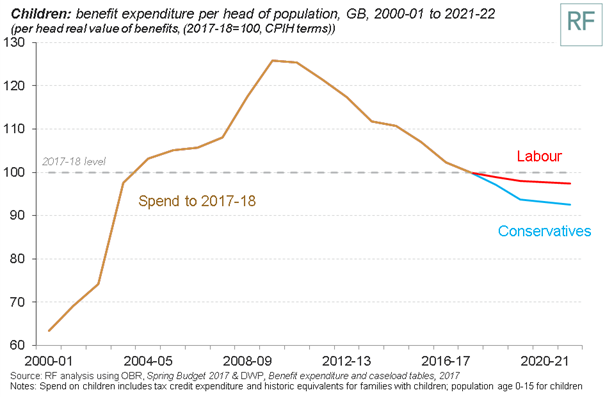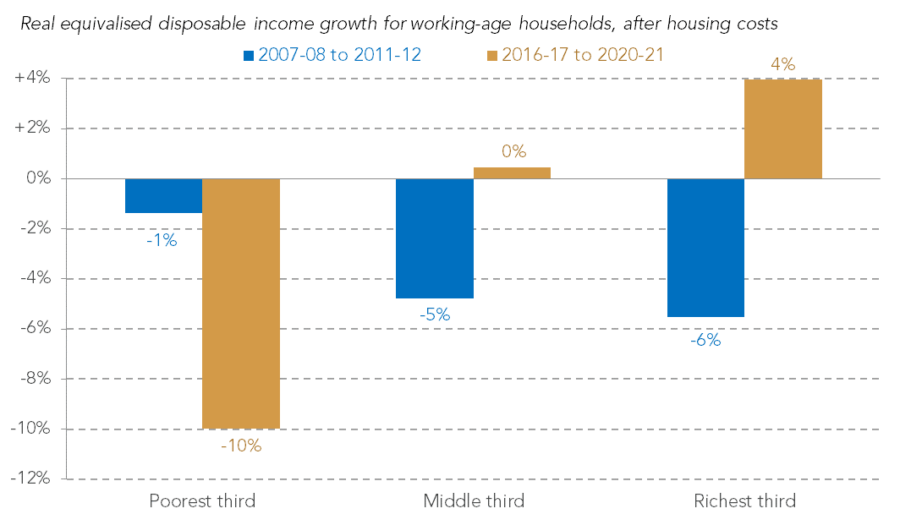The Resolution Foundation Sum-Up Election Benefits Battle
Saturday 27 May, 2017 Written by David Finch
We love a good welfare row in elections. Back in 2015, Labour was branded the ‘welfare party’ while the Conservatives were reluctant to divulge the details of the £12 billion cuts package they planned to announced shortly after the election. A cynic might wonder if they were planning to ditch that pledge in the ensuing coalition negotiations.
This time around we have a new welfare row, and this time it’s pensioner benefits – whether the state pension needs a double or triple lock (spoiler alert – its safe either way, for the next parliament at least), and who should get their Winter Fuel Payments.
Debating these issues is important, not least because it puts questions of intergenerational fairness up in lights at a time when the issue of about how best to use resources in the context of an ageing society really matter. But, while Winter Fuel Payments are significant, they represent only 1.5 per cent of all pensioner benefit spend. The risk is that this focus crowds out the debate we should really be having about the other side of intergenerational fairness and the biggest welfare challenge of the next parliament – what is happening to working-age people.
The big economic story at the moment is the unwelcome return of the living standards squeeze. And yet the Conservatives have been totally silent on the £9 billion of cuts to working age adults that they plan to roll out over the coming years. Oddly, Labour too do not want to talk about these cuts. Perhaps that’s because they are a considerable distance away from rejecting them in full, promising to reverse less than a quarter of the cuts. This lack of support betrays both parties’ rhetorical commitments to low-income working families, who have the daunting prospect of falling living standards by the end of the decade.
So what does the rather partial election welfare debate mean the parties are planning for the next parliament? Spending per-head on pensioner benefits is set to reach a record high, whoever wins the election. Under Labour, overall pensioner benefits per person are set to rise by 3.8% over the parliament. This could drop to 2.1% under the Conservatives, should they remove Winter Fuel Payments from all but the poorest pensioners who are entitled to Pension Credit. The quid pro quo is that those savings will transferred into social care, which is in dire need of more funding.

Crucially, despite the huge controversy over whether or not to keep the Triple Lock, the basic State Pension is set to rise by £780 in cash terms by 2021 under each of the main parties’ plans. Current OBR projections suggest there will be no difference between the ‘Triple Lock’ pledged by Labour and the ‘Double Lock’ offered by the Conservatives from 2020. The big savings are made over the coming decades, not the next few years.
In contrast to what is likely to happen to pensioner benefits, working age benefits (such as Job Seekers’ Alliance and Employment and Support Allowance) are set to fall in value. With neither of the main parties planning to reverse the ongoing freeze on benefits in their manifestos, benefits for working age adults could fall by 0.7% under Labour and 4.6% under the Conservatives. The remaining two years of the benefit freeze will leave a JSA claimant £190 a year worse off by 2021.
But the really big cuts – and the ones that should really worry those concerned about the living standards of low-income families – will be on benefits targeted at working families and children. These include over £3bn of cuts to in-work support via Universal Credit, removal of the family element, worth up to £545 a year; and the limiting of support to two children, worth up to £2,780 per child.fall would leave child benefits in 2020-21 still 15 per cent below pre-crisis levels, and no higher than they were back in 2003/04 despite our economy being 14 per cent bigger.

Labour’s Manifesto has allocated £2 billion to review UC. However, in truth this only reverses two-fifths of the cuts to Universal Credit and the child element and, when combined with two more years of the benefit freeze, would still mean per head child-related benefits falling by 2.6 per cent over the parliament.
The big picture backdrop to these welfare changes is a bleak outlook for living standards over the coming years. Our projections, based on the latest OBR forecasts for pay prices and employment, point to income stagnation for middle-income households, rising inequality and a 10% fall in household incomes for the poorest third of households. That fall would make the next four years even worse for low-income households than the great recession.

It appeared that both party leaders understood this challenge. Theresa May has talked about helping the ‘just about managing’ on the steps of Downing Street, while Jeremy Corbyn voted against George Osborne’s welfare cuts in July 2015 and has promised to govern ‘for the many, not the few’.
But this bold rhetoric has failed to translate into hard policy commitments in their Manifestos. With both parties planning big Budgets after the election, let’s hope they have a change of heart, correct this huge oversight, and make good on their rhetorical support for hard working families.
1 comment
-
Comment Link
 Saturday 27 May, 2017
posted by
Simon Collyer
Saturday 27 May, 2017
posted by
Simon Collyer
Leave a comment
Make sure you enter all the required information, indicated by an asterisk (*). HTML code is not allowed.
Join
FREE
Here










